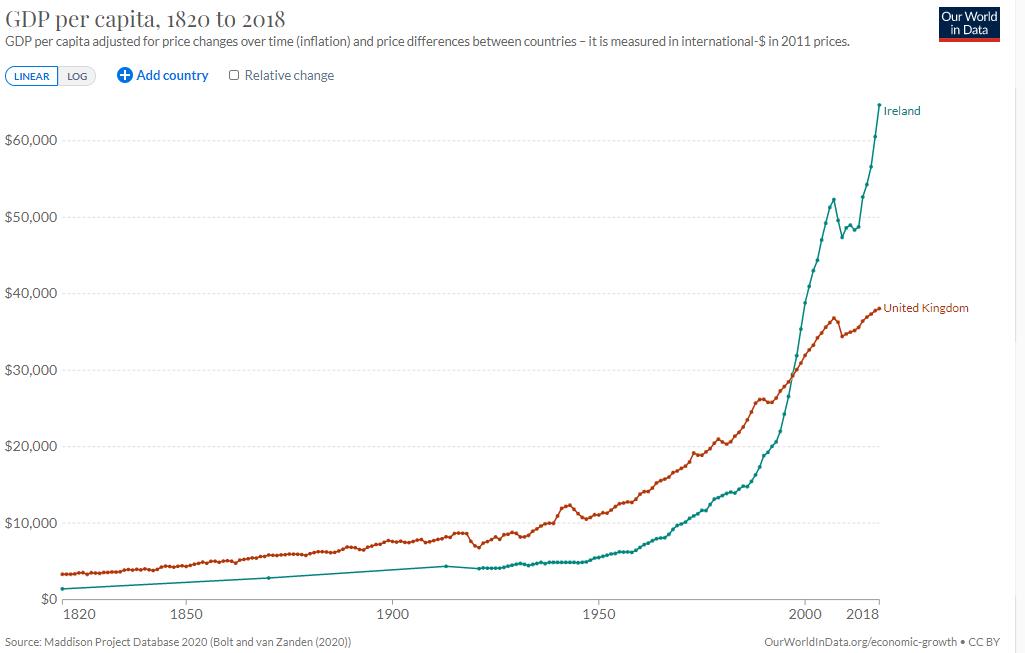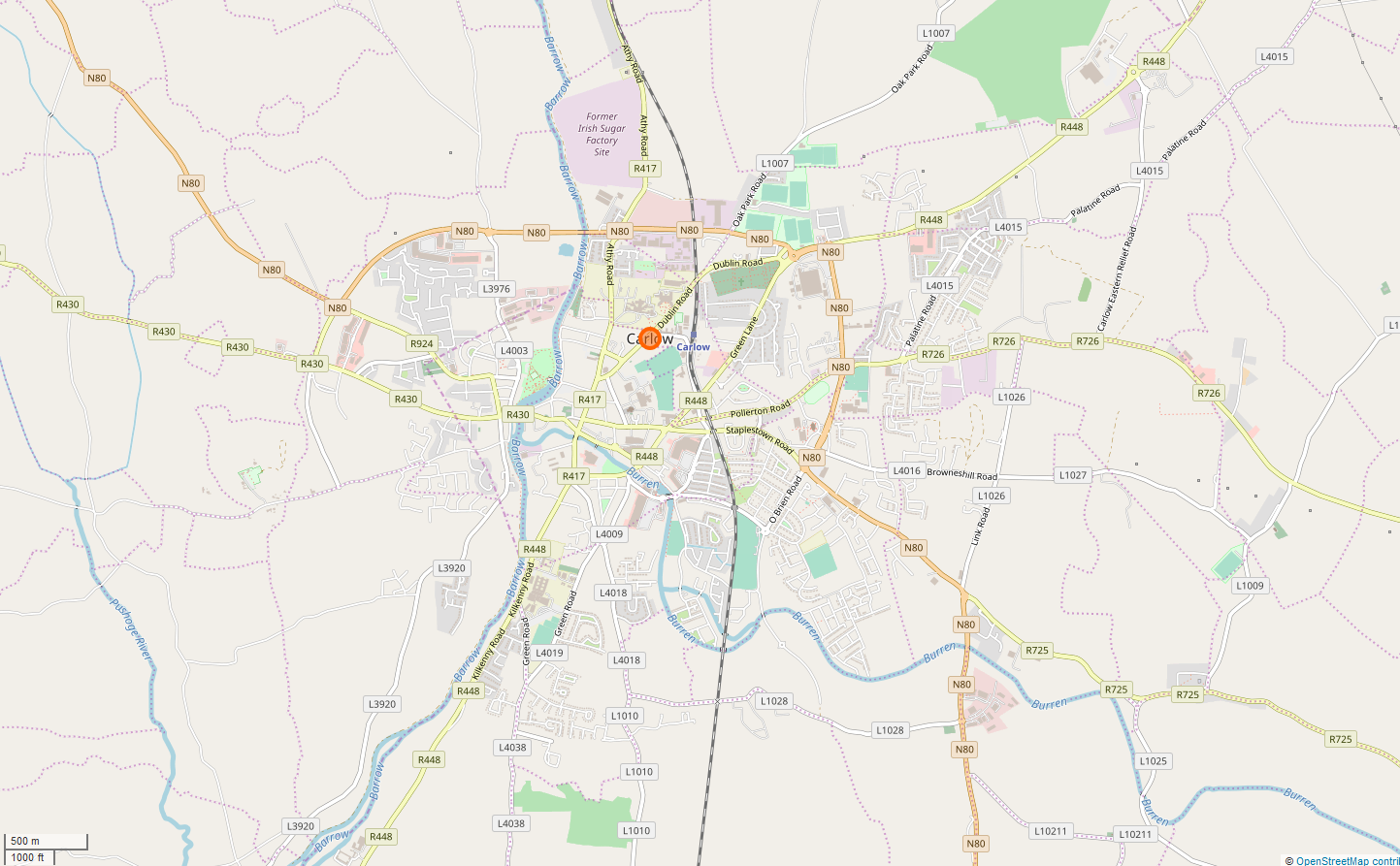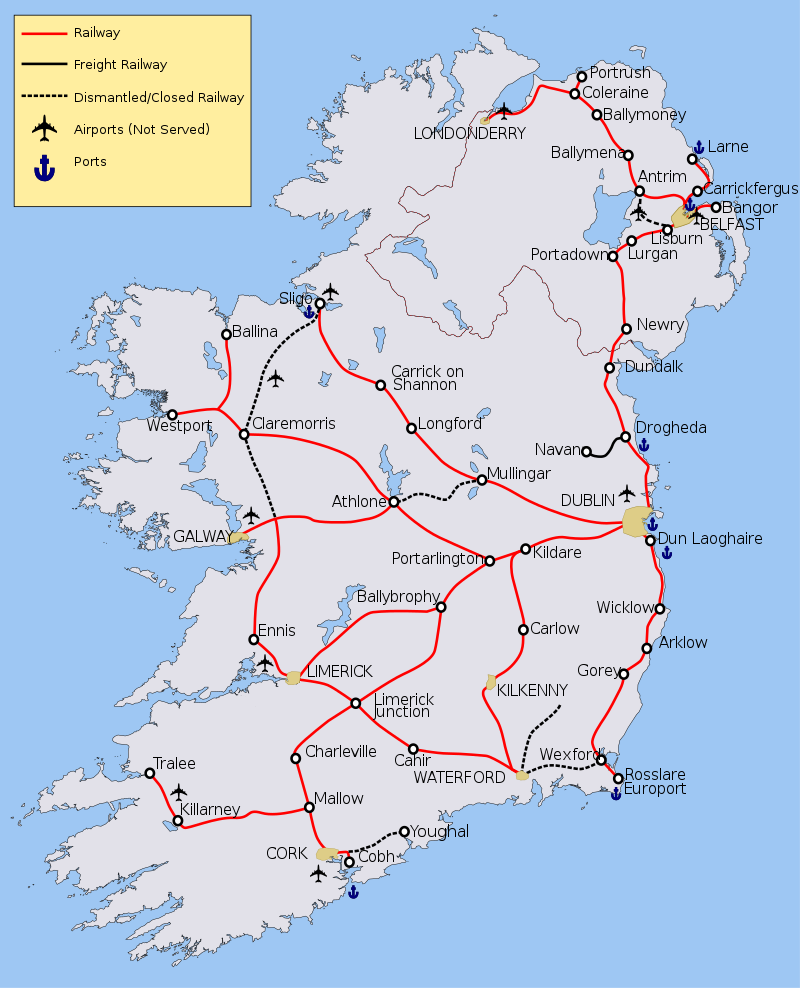|
Economic History Of The Republic Of Ireland
The economic history of the Republic of Ireland effectively began in 1922, when the then Irish Free State won independence from the United Kingdom of Great Britain and Ireland, United Kingdom. The state was plagued by poverty and emigration until the 1960s when an upturn led to the reversal of long term population decline. However, global and domestic factors combined in the 1970s and 1980s to return the country to poor economic performance and emigration. The 1990s, however saw the beginning of unprecedented economic success, in a phenomenon known as the "Celtic Tiger", which continued until the 2008 financial crisis, specifically the post-2008 Irish economic downturn. It also led to Republic of Ireland, Ireland becoming the most indebted state in the European Union. As of 2015, the Republic has returned to growth, and was the fastest growing economy for that year. In May 2023, Irish unemployment was at a record low of 3.8%. According to Oxford economic historian Kevin O'Rour ... [...More Info...] [...Related Items...] OR: [Wikipedia] [Google] [Baidu] |
United Kingdom
The United Kingdom of Great Britain and Northern Ireland, commonly known as the United Kingdom (UK) or Britain, is a country in Northwestern Europe, off the coast of European mainland, the continental mainland. It comprises England, Scotland, Wales and Northern Ireland. The UK includes the island of Great Britain, the north-eastern part of the island of Ireland, and most of List of islands of the United Kingdom, the smaller islands within the British Isles, covering . Northern Ireland shares Republic of Ireland–United Kingdom border, a land border with the Republic of Ireland; otherwise, the UK is surrounded by the Atlantic Ocean, the North Sea, the English Channel, the Celtic Sea and the Irish Sea. It maintains sovereignty over the British Overseas Territories, which are located across various oceans and seas globally. The UK had an estimated population of over 68.2 million people in 2023. The capital and largest city of both England and the UK is London. The cities o ... [...More Info...] [...Related Items...] OR: [Wikipedia] [Google] [Baidu] |
Anglo-Irish Trade War
The Anglo-Irish Trade War (also called the Economic War) was a retaliatory trade war between the Irish Free State and the United Kingdom from 1932 to 1938. The Irish government refused to continue reimbursing Britain with land annuities from financial loans granted to Irish tenant farmers to enable them to purchase lands under the Irish Land Acts in the late nineteenth century, a provision which had been part of the 1921 Anglo-Irish Treaty. This resulted in the imposition of unilateral trade restrictions by both countries. The "war" had two main aspects: * Disputes surrounding the changing constitutional status of the Irish Free State vis-à-vis Britain; * Irish economic and fiscal policy changes following the Great Depression. Protective policy On taking over power and coming into office in 1932, the new Fianna Fáil government under Éamon de Valera embarked upon a protectionist policy in economic dealings, and tariffs were introduced for a wide range of imported goods, main ... [...More Info...] [...Related Items...] OR: [Wikipedia] [Google] [Baidu] |
Fianna Fáil
Fianna Fáil ( ; ; meaning "Soldiers of Destiny" or "Warriors of Fál"), officially Fianna Fáil – The Republican Party (), is a centre to centre-right political party in Ireland. Founded as a republican party in 1926 by Éamon de Valera and his supporters after they split from Sinn Féin in order to take seats in the Oireachtas, which Sinn Féin refused to recognise, since 1927 Fianna Fáil has been one of Ireland's two major parties, along with Fine Gael since 1933; both are seen as centre-right parties, to the right of the Labour Party and Sinn Féin. The party dominated Irish political life for most of the 20th century, and, since its foundation, either it or Fine Gael has led every government. Between 1932 and 2011, it was the largest party in Dáil Éireann, but latterly with a decline in its vote share; from 1989 onwards, its periods of government were in coalition with parties of either the left or the right. Fianna Fáil's vote collapsed in the 2011 ge ... [...More Info...] [...Related Items...] OR: [Wikipedia] [Google] [Baidu] |
Mary E
Mary may refer to: People * Mary (name), a female given name (includes a list of people with the name) Religion * New Testament people named Mary, overview article linking to many of those below * Mary, mother of Jesus, also called the Blessed Virgin Mary * Mary Magdalene, devoted follower of Jesus * Mary of Bethany, follower of Jesus, considered by Western medieval tradition to be the same person as Mary Magdalene * Mary, mother of James * Mary of Clopas, follower of Jesus * Mary, mother of John Mark * Mary of Egypt, patron saint of penitents * Mary of Rome, a New Testament woman * Mary the Jewess, one of the reputed founders of alchemy, referred to by Zosimus. Royalty * Mary, Countess of Blois (1200–1241), daughter of Walter of Avesnes and Margaret of Blois * Mary of Burgundy (1457–1482), daughter of Charles the Bold, Duke of Burgundy * Queen Mary of Denmark (born 1972), wife of Frederik X of Denmark * Mary I of England (1516–1558), aka "Bloody Mary", Queen ... [...More Info...] [...Related Items...] OR: [Wikipedia] [Google] [Baidu] |
Carlow
Carlow ( ; ) is the county town of County Carlow, in the south-east of Republic of Ireland, Ireland, from Dublin. At the 2022 census of Ireland, 2022 census, it had a population of 27,351, the List of urban areas in the Republic of Ireland, twelfth-largest urban center in Ireland. The River Barrow flows through the town and forms the historic boundary between counties County Laois, Laois and Carlow. However, the Local Government (Ireland) Act 1898 included the town entirely in County Carlow. The settlement of Carlow is thousands of years old and pre-dates written Irish history. The town has played a major role in Irish history, serving as the capital of the country in the 14th century. The town is in a townland and Civil parishes in Ireland, civil parish of the same name. Etymology The name is an anglicisation of the Irish language, Irish ''Ceatharlach''. Historically, it was anglicised as ''Caherlagh'', ''Caterlagh'' and ''Catherlagh'', which are closer to the Irish spell ... [...More Info...] [...Related Items...] OR: [Wikipedia] [Google] [Baidu] |
Irish Sugar Company
Greencore Group plc is a food company in Ireland. It was established by the Irish government in 1991, when Irish Sugar was privatised, but today Greencore's products are mainly convenience foods, not only in Ireland but also in the United Kingdom. A major supplier to British and Irish supermarkets, Greencore is the largest sandwich manufacturer in the world. It is listed on the London Stock Exchange and is a constituent of the FTSE 250 Index. History The company was established in 1926 in Carlow as a private enterprise known as the ''Irish Sugar Manufacturing Company, Limited''. The Sugar Manufacture Act, 1933 was passed to promote self-sufficiency in sugar manufacture; this Act was brought on by a crisis in the industry and resulted in the nationalisation of sugar manufacture. Factories were built in Mallow, Thurles and Tuam, and the company became ''Cómhlucht Siúicre Éireann, Teoranta'', the Irish for ''Irish Sugar Company, Limited''. When run by Michael Joe Costello, Iris ... [...More Info...] [...Related Items...] OR: [Wikipedia] [Google] [Baidu] |
Dublin
Dublin is the capital and largest city of Republic of Ireland, Ireland. Situated on Dublin Bay at the mouth of the River Liffey, it is in the Provinces of Ireland, province of Leinster, and is bordered on the south by the Dublin Mountains, part of the Wicklow Mountains range. Dublin is the largest city by population on the island of Ireland; at the 2022 census of Ireland, 2022 census, the city council area had a population of 592,713, while the city including suburbs had a population of 1,263,219, County Dublin had a population of 1,501,500. Various definitions of a metropolitan Greater Dublin Area exist. A settlement was established in the area by the Gaels during or before the 7th century, followed by the Vikings. As the Kingdom of Dublin grew, it became Ireland's principal settlement by the 12th century Anglo-Norman invasion of Ireland. The city expanded rapidly from the 17th century and was briefly the second largest in the British Empire and sixth largest in Western Europ ... [...More Info...] [...Related Items...] OR: [Wikipedia] [Google] [Baidu] |
Belfast
Belfast (, , , ; from ) is the capital city and principal port of Northern Ireland, standing on the banks of the River Lagan and connected to the open sea through Belfast Lough and the North Channel (Great Britain and Ireland), North Channel. It is the second-largest city in Ireland (after Dublin), with an estimated population of in , and a Belfast metropolitan area, metropolitan area population of 671,559. First chartered as an English settlement in 1613, the town's early growth was driven by an influx of Scottish people, Scottish Presbyterian Church in Ireland, Presbyterians. Their descendants' disaffection with Kingdom of Ireland, Ireland's Protestant Ascendancy, Anglican establishment contributed to the Irish Rebellion of 1798, rebellion of 1798, and to the Acts of Union 1800, union with Kingdom of Great Britain, Great Britain in 1800—later regarded as a key to the town's industrial transformation. When granted City status in the United Kingdom#Northern Ireland, city s ... [...More Info...] [...Related Items...] OR: [Wikipedia] [Google] [Baidu] |
Rail Transport In Ireland
Rail transport in Ireland (InterCity, commuter and freight) is provided by Iarnród Éireann in the Republic of Ireland and by Northern Ireland Railways in Northern Ireland. Most routes in the Republic radiate from Dublin. Northern Ireland has suburban routes from Belfast and two main InterCity lines, to Derry and cross-Irish border, border to Dublin. The accompanying map of the current railway network shows lines that are fully operational (in red), carrying freight only traffic (in black) and with dotted black lines those which have been "mothballed" (i.e. closed to traffic but potentially easy to re-open). Some airports are indicated but none are rail-connected, although Kerry Airport and Belfast City Airport are within walking distance of a railway station. Both the City of Derry Airport and Belfast International Airport, Belfast International (Aldergrove) are near railway lines but not connected. Ports are marked, although few remain rail-connected. Dublin Port, Larne Har ... [...More Info...] [...Related Items...] OR: [Wikipedia] [Google] [Baidu] |
Derry
Derry, officially Londonderry, is the second-largest City status in the United Kingdom, city in Northern Ireland, and the fifth-largest on the island of Ireland. Located in County Londonderry, the city now covers both banks of the River Foyle. Cityside and the old walled city being on the west bank and Waterside, Derry, Waterside on the east, with two road bridges and one footbridge crossing the river in-between. The population of the city was 85,279 in the 2021 census, while the Derry Urban Area had a population of 105,066 in 2011. The district administered by Derry City and Strabane District Council contains both Londonderry Port and City of Derry Airport. Derry is close to the Irish border, border with County Donegal, with which it has had a close link for many centuries. The person traditionally seen as the founder of the original Derry is Saint , a holy man from , the old name for almost all of modern County Donegal, of which the west bank of the Foyle was a part befor ... [...More Info...] [...Related Items...] OR: [Wikipedia] [Google] [Baidu] |
County Donegal
County Donegal ( ; ) is a Counties of Ireland, county of the Republic of Ireland. It is in the Provinces of Ireland, province of Ulster and is the northernmost county of Ireland. The county mostly borders Northern Ireland, sharing only a small border with the rest of the Republic. It is named after the town of Donegal (town), Donegal in the south of the county. It has also been known as County Tyrconnell or Tirconaill (), after Tyrconnell, the historical territory on which it was based. Donegal County Council is the local government in the Republic of Ireland, local council and Lifford is the county town. The population was 167,084 at the 2022 census of Ireland, 2022 census. Name County Donegal is named after the town of Donegal (town), Donegal () in the south of the county. It has also been known by the alternative name County Tyrconnell or Tirconaill (, meaning 'Land of Conall Gulban, Conall'). The latter was its official name between 1922 and 1927. This is in reference to th ... [...More Info...] [...Related Items...] OR: [Wikipedia] [Google] [Baidu] |







